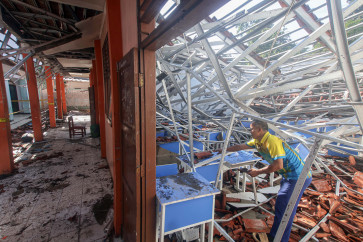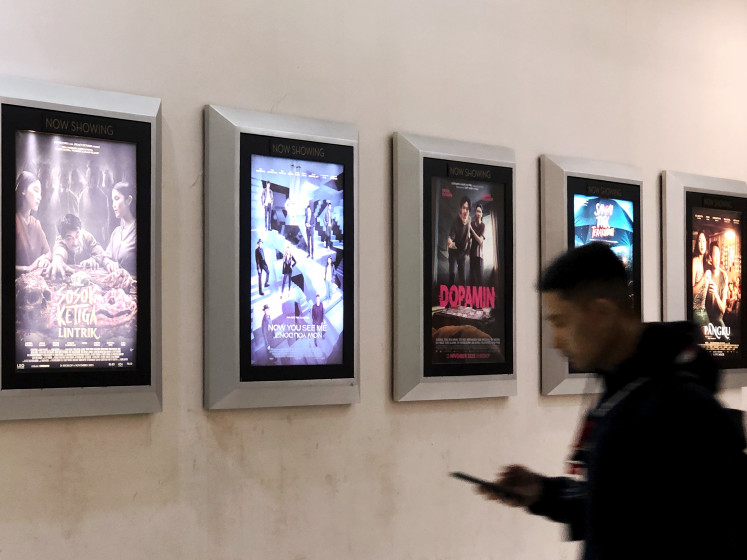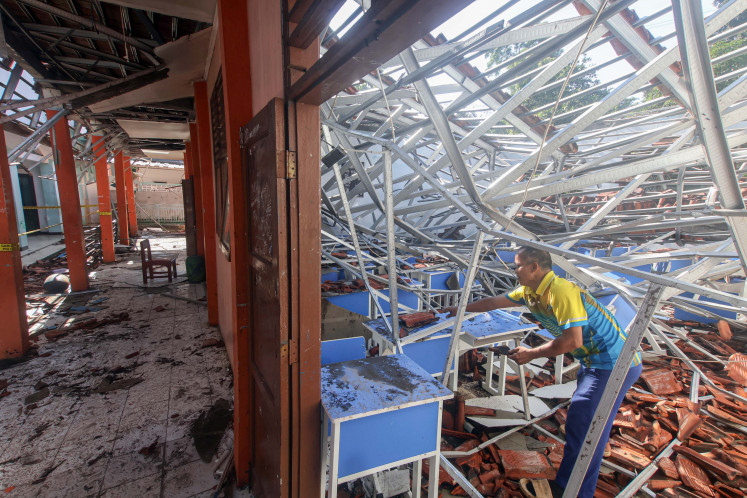Popular Reads
Top Results
Can't find what you're looking for?
View all search resultsPopular Reads
Top Results
Can't find what you're looking for?
View all search resultsMade Wianta: Razor sharp
Made Wianta has made a name for himself as one of Bali’s most inventive and prolific artists
Change text size
Gift Premium Articles
to Anyone
M
ade Wianta has made a name for himself as one of Bali’s most inventive and prolific artists. Using everything from paint and fabrics to razor blades, Wianta’s creativity seems boundless.
Courtesy of Made Wianta
It was a drizzly afternoon in Denpasar at Made Wianta’s studio and home. In order to enter the studio, visitors must first climb a flight of gray stone stairs that feels like entering a temple.
The studio was filled with muted colored wood and stones. In contrast to the stark white walls, the space was accentuated by some of Wianta’s more recent, and daring, works of art.
Calm and breezy, the art studio was filled with large windows overlooking a green garden and pond. The calm and serene ambiance of the scene belied the personality of the man of the house.
“Tell me, what is your story?” Made Wianta said after our introduction. Satisfied with the answers, he then opened up about himself.
Born in Tabanan as the youngest of 10 children, Wianta grew up in a musical and artistic household. His father Labdana was a cleric whose job was to lead processions of religious events. His family all played Balinese gamelan, and some of his siblings went on to become shadow puppet masters.
“I became an artist because I grew up in that musical and performing arts environment, but not in visual arts. So painting and drawing were not something I was confident
doing as a child,” said Wianta. He never received formal education in visual art; Wianta was instead trained in music and dance at Sekolah Tinggi Seni Rupa Indonesia (STSRI) Asri Yogyakarta, where he met his wife, Intan.
Wianta’s lack of education in visual art did not deter him from jumping head first into the scene. When living in Belgium and working at an import-export company, Wianta was introduced to the vibrant art scene there, where he had the opportunity to learn about western and classical art.
Upon his return from Belgium and the birth of his first daughter, Wianta decided to immerse himself professionally as an artist. “My first solo show was in 1976 in the Jacques Franck Cultural Center in Brussels. For me, having a show in Europe at that time was interesting because it was rare for a third-world artist to have the opportunity for a solo show. That experience encouraged me to continue my experiments and move forward creatively.
“Why don’t I show you around?” the artist said suddenly. As I followed him through his studio and house, Wianta seemed to grow even more energetic.
“I designed this house myself. I sometimes get a bit bored, so I like to tear down and renovate my house. It’s from all this energy,” he explained as we went down the winding staircase to his gallery.
He proudly showed me his immense collection of sketches and drawings. Wianta’s assistants pulled out examples of the work he’d done throughout his years as an artist.
“I don’t really have a certain linear way of creating,” he explained when asked about his process. “I just do whatever comes to mind naturally. Usually, for my own art project, I receive inspiration by observing nature. Sometimes there are no connections from one work to another,” he said. His carefully catalogued works span decades and subjects, as if creating order from chaos.
A whirlwind of a man, Made Wianta seems to also construct his thoughts in a nonlinear manner. He jumps from one subject to another, as if always thinking about a number of different subjects at the same time. “I often draw inspiration from my environment,” he said.
Explaining the method to his art, Wianta said that his projects reflect the zeitgeist of the island. “My project Art & Peace in 1999 was a response to what was going on then. Then Dreamland in 2002 was a response to the terrorist attacks in Bali.”
Pointing to his most recent works, a large canvas with hundreds of rusted razor blades, Wianta grew even more animated. “I really like sharp things as of late. This piece was inspired by the keris dagger dance, where many men point their keris aggressively forward in a march.”
Wianta’s work is not limited to visual arts. Recently performing The Dance on the Dance in December 2010 for an art opening at MahaArt in Sanur, Wianta reached back to his musical roots for future projects.
“In September 2011, I am doing a musical collaboration in Dallas for three months. Aside from that, I will be teaching a performance arts course at Holy Cross University in Massachusetts from January to June 2011.”
When asked about the current state of modern art in Bali, Wianta grew contemplative. “Unfortunately, the modern and contemporary art scene has stalled because there isn’t any global art appreciation, there is a lack of literature and a weak infrastructure, whether publicly or privately supported. So now there is a stagnation.”
He said, “Ideally, as with globalization, Bali could become a doorway for Indonesia to contribute and take part in the art chess game that is local or international.”
Accustomed to working abroad, Wianta sees the disparity between the local and international audience’s appreciation as a disappointment that should be amended.
He would rather see a concentrated effort from not only Bali’s local government but also from the central government in Jakarta to create a supportive infrastructure to encourage the arts.
He feels strongly against the recent “rudderless commercialization of Balinese art.
“I feel that the arts should be directed toward creativity and strong appreciation. We need a supportive infrastructure. Bali, as a tourist destination, has many five star hotels and yet we don’t have any internationally renowned gallery or museum.”
Then as if snapping out of his contemplation, Wianta called his wife and asked her if she was ready. He then turned and asked, “So, what would you like to eat for dinner?”










